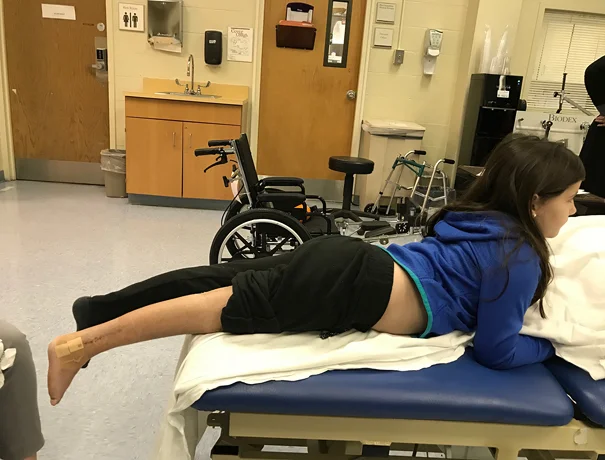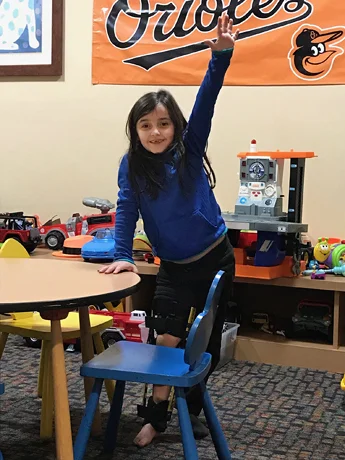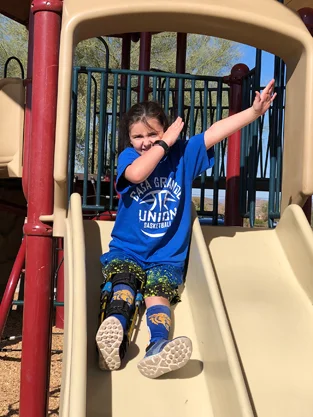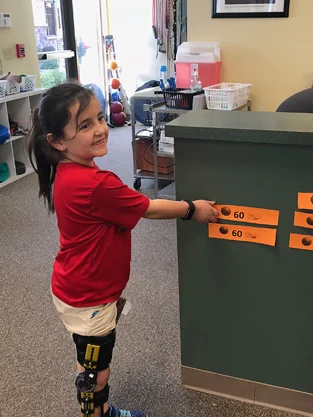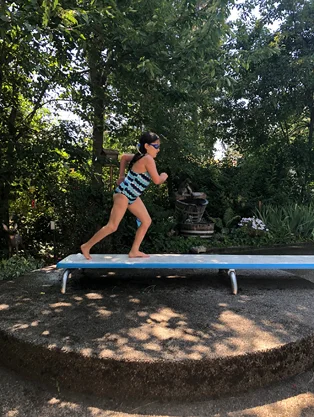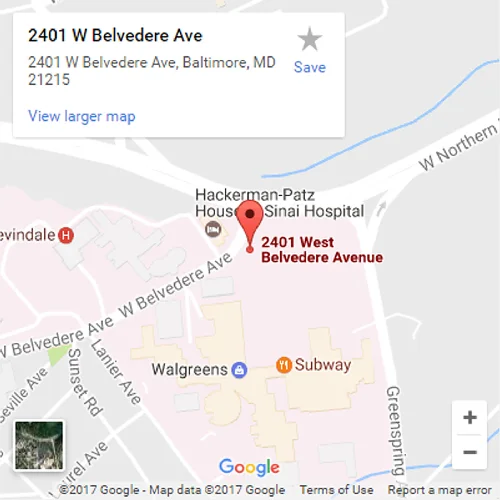Gracie
Fibular Hemimelia Arizona Dr. Standard
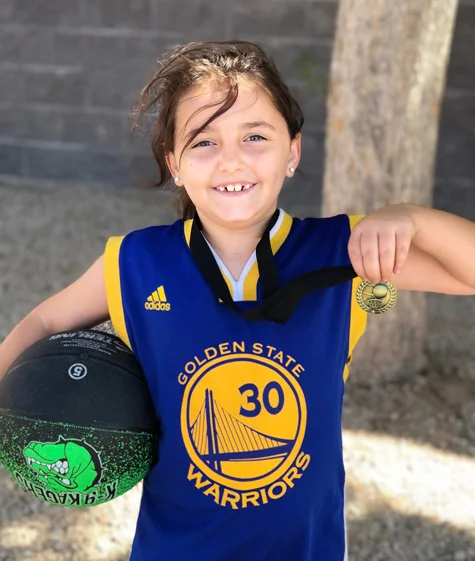 Gracie’s mom, Heather, shares, “Before coming to the Rubin Institute, we had no idea what the care plan was going to look like. The condition is rare, and it’s even more rarely treated by orthopedic doctors in Arizona. While she was correctly diagnosed in Arizona, they weren’t comfortable giving us any specifics of what we would be looking at long term for either her care or her physical abilities. At our very first appointment we were told that, ‘someone may recommend amputation, but I don’t think that will be necessary for her. She will most likely walk, but it could be severely delayed.’ Hearing that information, but not being given any plans as to what we could or should do to help her, caused us to start researching not only common methods of treatment, but also doctors with more experience. Initially, we were terrified that she wouldn’t walk, run, jump or play like typical kids.”
Gracie’s mom, Heather, shares, “Before coming to the Rubin Institute, we had no idea what the care plan was going to look like. The condition is rare, and it’s even more rarely treated by orthopedic doctors in Arizona. While she was correctly diagnosed in Arizona, they weren’t comfortable giving us any specifics of what we would be looking at long term for either her care or her physical abilities. At our very first appointment we were told that, ‘someone may recommend amputation, but I don’t think that will be necessary for her. She will most likely walk, but it could be severely delayed.’ Hearing that information, but not being given any plans as to what we could or should do to help her, caused us to start researching not only common methods of treatment, but also doctors with more experience. Initially, we were terrified that she wouldn’t walk, run, jump or play like typical kids.”
When asked about her daughter’s treatment at the International Center for Limb Lengthening, Heather responds, “For Gracie, it’s life changing. She receives the best possible care and has been able to run, jump and play like a typical kid. She has had 13 surgeries to date, 12 of which occurred on her leg at the Rubin Institute. Typically, this would result in a child with a major fear of hospitals and doctors, but that is not at all the case with her. Everyone, from the Hackerman-Patz House, to the X-ray technicians, pre-op nurses, post-op nurses, inpatient nurses, anesthesiologist, Marilyn [Richardson, Pediatric Liaison], Chris [Fisher, Physician Assistant], Allison [Lynn, Physician Assistant], all the way to Dr. Standard have developed a routine and type of care that truly works for kids. She isn’t afraid of doctors or hospitals, and although she’s not always happy about needing surgery or the post-op recovery, she literally jumps out of her seat to hug Dr. Standard every time she sees him. Baltimore has become our home away from home, and it’s because of the care at every level that is given. Our last surgery was in October, and just this week Gracie was telling me what she wanted to pack for our next trip out. She said she misses Dr. Standard and wants to go see him again. This girl only sees Dr. Standard when he is operating on her, and despite that knowledge and routine, she misses him. She misses Marilyn and Baltimore, and it just is such a comfort for the both of us. The surgeries have done wonders for her foot and leg. Some were more visibly impactful than others, while some just internally strengthened the structure of her leg. All though have blended together to give her the opportunity to have as structurally strong of a leg and foot as possible and helped her to be able to be a typical 7-year-old.”
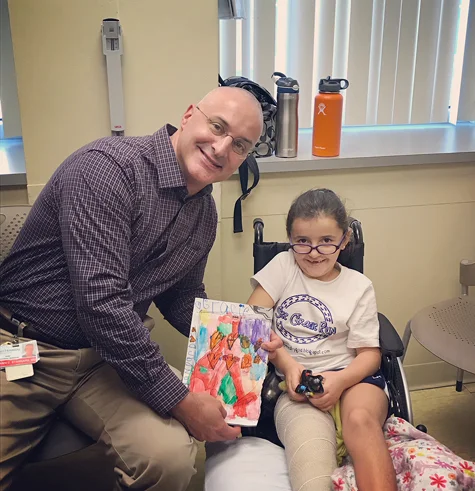 Heather adds, “As a parent, I am very confident in not only her treating doctor, but the entire team. That alone is a huge weight off my shoulders. Knowing we have her at the best possible place allows some respite in my heart when I think of all she has gone and will go through. We have looked into multiple opinions to try and find somewhere closer to Arizona, but no one we saw made us as comfortable, was as welcoming or as experienced as the staff at the Rubin Institute. When you struggle with having to make choices for your child that you know, no matter which route you go, will bring physical and sometimes mental pain….trusting the staff the way we do makes all the difference.”
Heather adds, “As a parent, I am very confident in not only her treating doctor, but the entire team. That alone is a huge weight off my shoulders. Knowing we have her at the best possible place allows some respite in my heart when I think of all she has gone and will go through. We have looked into multiple opinions to try and find somewhere closer to Arizona, but no one we saw made us as comfortable, was as welcoming or as experienced as the staff at the Rubin Institute. When you struggle with having to make choices for your child that you know, no matter which route you go, will bring physical and sometimes mental pain….trusting the staff the way we do makes all the difference.”
She continues, “I happened to overhear a parent in the waiting room on our last visit, waiting to be seen by either Dr. Standard or Dr. Herzenberg. She was frustrated at how long they were having to wait, and it was her first appointment. While I get that, my first thought was that I would literally wait all day for my appointment if I had to. My goodness… we travel across country for these visits. Initially, we first met Dr. Standard and Dr. Herzenberg on a web chat where I showed Dr. Standard pictures of Gracie’s first set of X-rays. I was instantly hooked on the family-like atmosphere of those chats. Here I was, knee deep in medical information I didn’t understand, overwhelmed with a newborn, and this chat was like a family reunion. The doctors were giving serious medical information along with casual side conversations, some of which were joking and funny. It was like being the new person at a family dinner, and it just blew me away how real and comfortable it was. To be talking with two of the best surgeons in the world for this condition and feeling comfortable and related to was something I’ll never be able to accurately describe.”
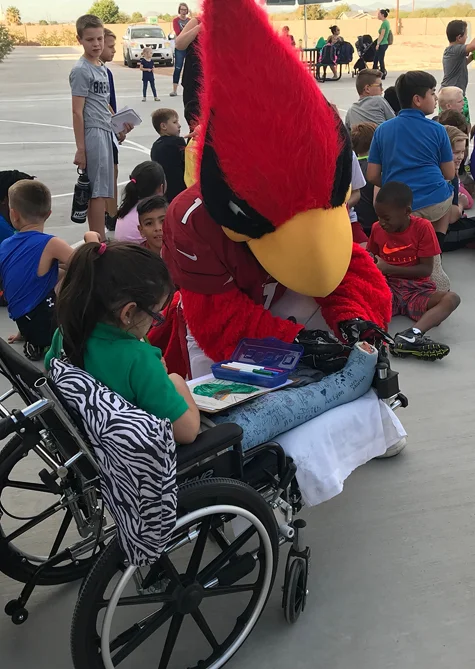 Heather shares, “Once we set up an initial in person evaluation, I, being the organized soul that I am, had a list (pages long) of questions for Dr. Standard when we finally got there. He did not make fun of my list or my questions, and took the time to answer every single one. He talked in terminology that I could understand and made sure I was comfortable and grasping everything. There were some vague ideas, but there were so many more concretes than what we were given by doctors at home, that I felt like I had a much better grasp of what we were looking at.”
Heather shares, “Once we set up an initial in person evaluation, I, being the organized soul that I am, had a list (pages long) of questions for Dr. Standard when we finally got there. He did not make fun of my list or my questions, and took the time to answer every single one. He talked in terminology that I could understand and made sure I was comfortable and grasping everything. There were some vague ideas, but there were so many more concretes than what we were given by doctors at home, that I felt like I had a much better grasp of what we were looking at.”
She continues, “Dr. Standard has, by far, the most knowledge and best bedside manner I have ever seen in a doctor in my lifetime. He includes not only me, but also Gracie in conversations. Instead of ignoring her at our appointments, he explains everything to with age-appropriate information and then moves on to go over it with me. We work so hard to teach her how to have her own voice in this journey, so that one day when she’s older, she’s comfortable with having an opinion, speaking up about concerns, etc. Dr. Standard only backs that up with the way he treats her every time. I have never felt rushed out of an appointment or that my concerns were glossed over.”
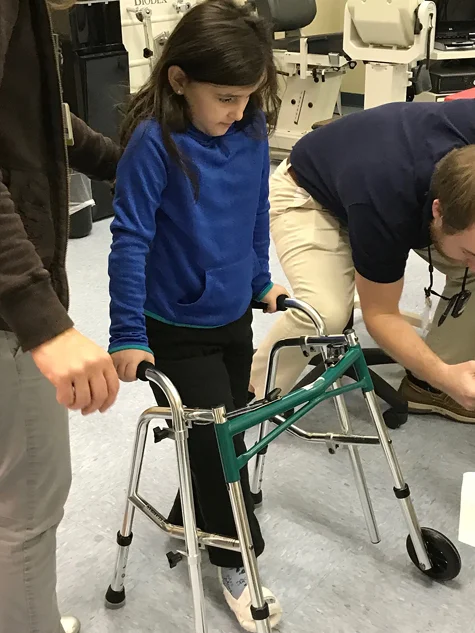 When asked what she would share with other parents with a newly diagnosed baby with fibular hemimelia, Heather responds, “It is worth every single sacrifice it takes to get your child treated at RIAO [Rubin Institute for Advanced Orthopedics]…. This is such a hard journey and there will be so many times you wonder, (not necessarily second guess), but just wonder what choosing a different path would be like; so having confidence in the skill and trust in the surgeon is a comfort you can’t put a price tag on.”
When asked what she would share with other parents with a newly diagnosed baby with fibular hemimelia, Heather responds, “It is worth every single sacrifice it takes to get your child treated at RIAO [Rubin Institute for Advanced Orthopedics]…. This is such a hard journey and there will be so many times you wonder, (not necessarily second guess), but just wonder what choosing a different path would be like; so having confidence in the skill and trust in the surgeon is a comfort you can’t put a price tag on.”
She adds, “I would also tell them to remember that even though this group is, in my opinion, the best in the world, they are still human. As parents I think we can get caught up in wanting perfection for our kids, and I totally get that, but we can’t expect that from them. They may make mistakes, there may be unforeseen complications, care plans literally can change with each growth spurt your child has, but you will NEVER find a group of individuals who continue to arm themselves with the most recent medical knowledge and technology; who truly love what they are doing—not for the notoriety of dealing with a rare condition, but for the ability to change and improve a child’s quality of life; and who truly play off of each other’s strengths—working together to try and make the process as easy for your child as it can be—from start to finish.”
These pictures track Gracie from the time of her wearing a cast and using a wheelchair after SUPERknee surgery, to her graduating to a walker, then a brace, and then cleared to play basketball again. Click here to see a news clip about Gracie’s treatment.
